2Q 2024 Review and Outlook
Equity markets almost always have drama, but this quarter the drama was largely behind the scenes. After starting the quarter with a substantial pullback of nearly 6% in the S&P 500, the market shifted to a relentless grind higher, which produced only one day with the market moving more than 1.5% in either direction. A different story can be told if you look below the index level. The market capitalization weighted S&P 500 Index posted strong returns of +4.3% but the S&P equal-weighted index (an index of all 500 stocks equally weighted) was down -2.7%. Chalk this up to strong performance from just a few very large stocks in the technology sector driving the overall returns; the remaining names in the basket struggled. Small-caps and international developed indices were also down, while international emerging market stocks managed to best all stock categories with a solid +5% gain.
Technology, Communications Services and Utilities posted the strongest gains of the quarter, while Materials, Industrials and Energy were down notably.
Bond returns were mixed during the quarter. While the benchmark 10-yr Treasury yield ended at 4.36%, slightly higher than the 4.20% at the beginning of the quarter (negative for pricing), coupon income was sufficient to push investment grade bonds to positive returns for the period. Municipal bond indexes were off slightly.
S&P 500 continues 2024 advance
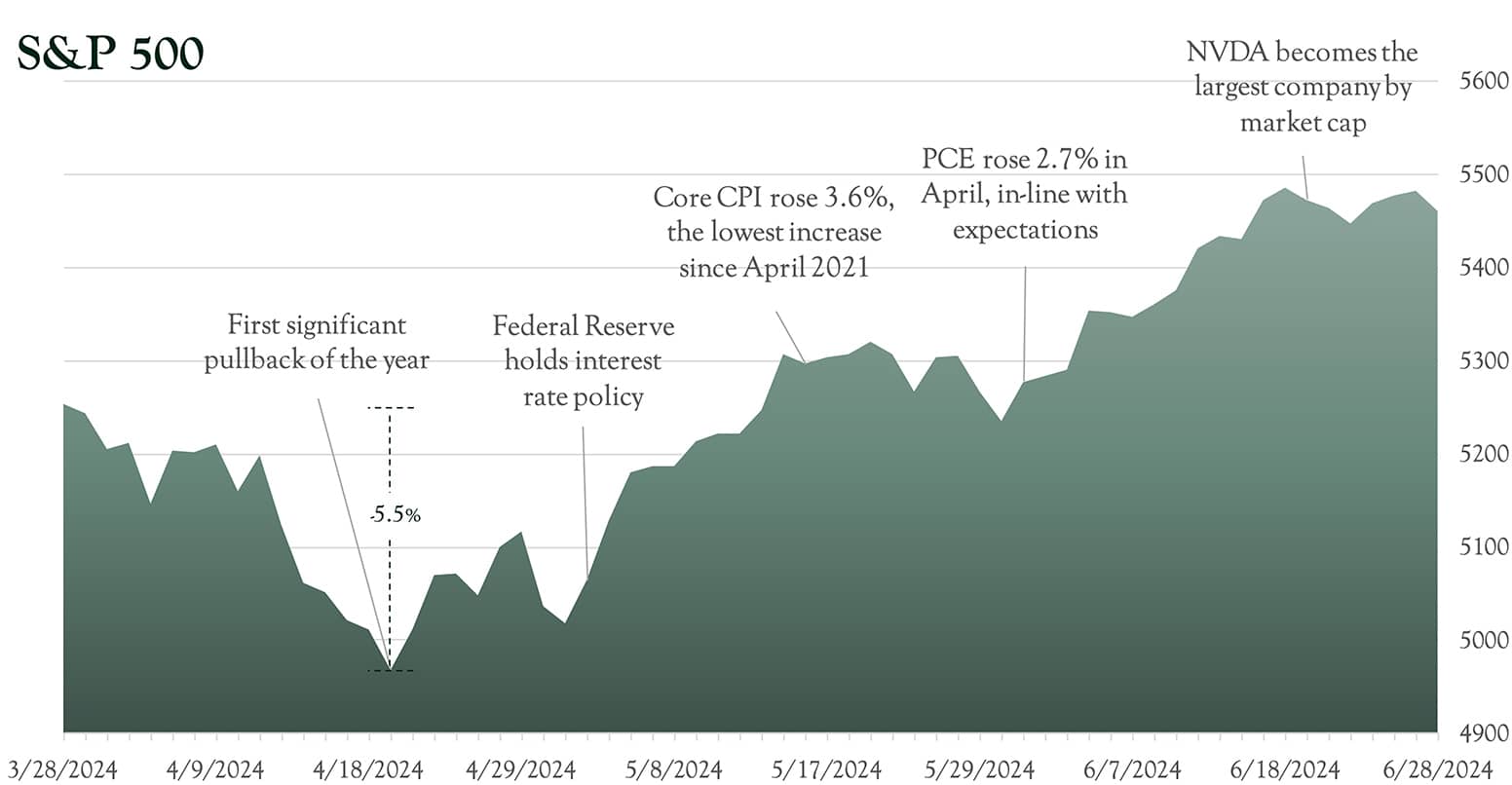
What drove the stock market?
“What’s Changed?” is a simple explanation of what happened in S&P 500 during the most recent period but does not necessarily explain why the market moved. Let’s explore the “why” by looking at three individual components that shape market changes.
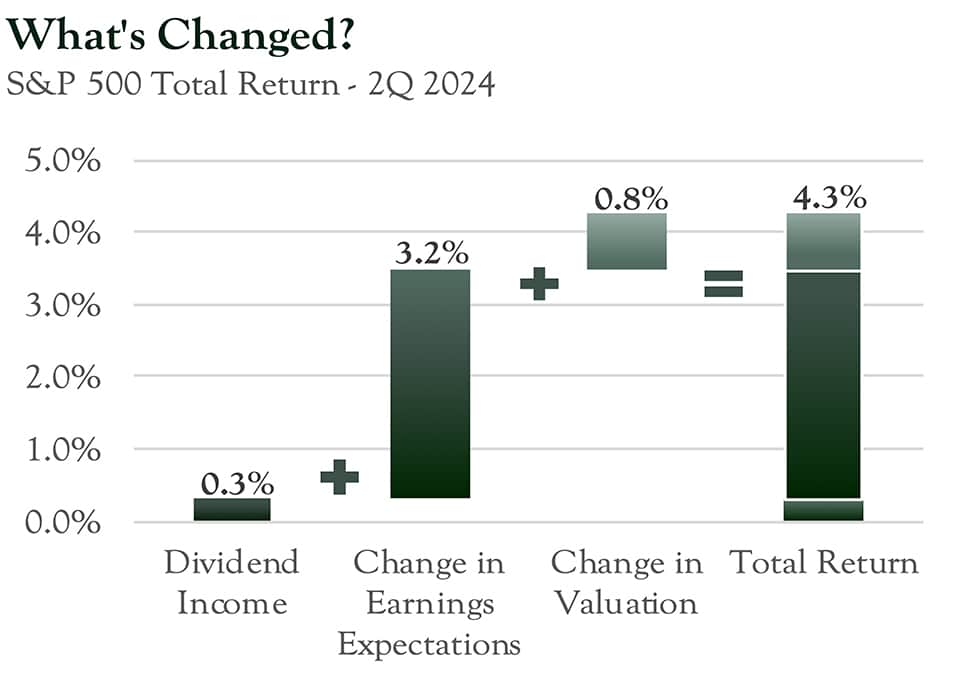
Dividend Yield: This is the most stable of the three factors. Dividend yields were approximately +0.3% this quarter (roughly 1.2% annualized).
Change in Earnings Expectations: Over the long term, earnings tend to drive stock prices. Earnings expectations rose +3.2%, a strong number similar to the estimate in the first quarter.
Change in Valuation (Price/Earnings ratio): This number is generally more volatile than the earnings component – it is a measure of how investors value company earnings. With inflation news remaining an important component for valuing earnings, this quarter’s economic data left the Price/Earnings ratio little changed at +0.8%. Strong economic growth coupled with higher than desired inflation data diminished hopes for rate cuts. As shown in the chart below, by quarter’s end, investors were expecting far fewer potential Fed rate cuts than at the beginning of the quarter.
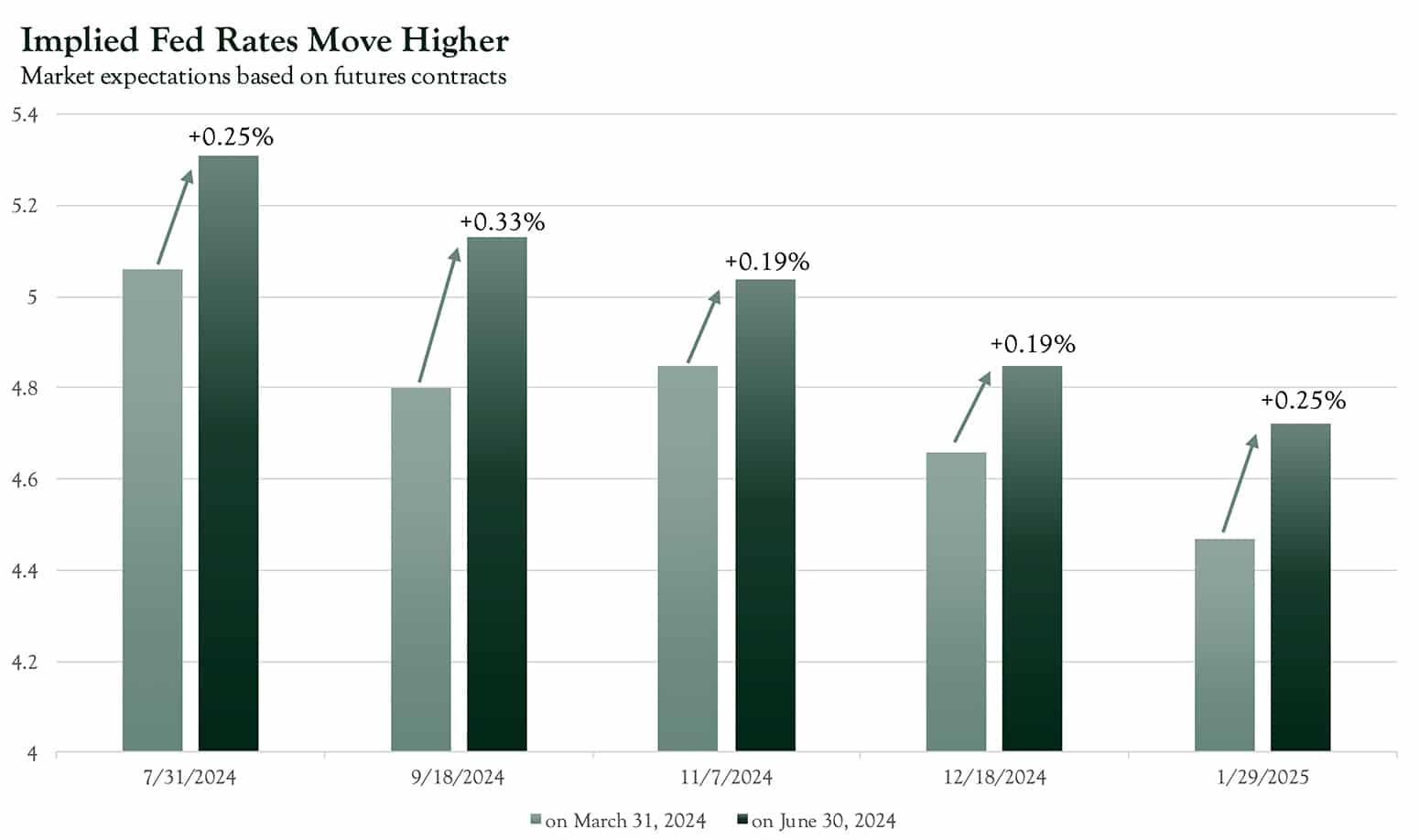
What drove the bond market?
While inflation and Fed rate cut probabilities get the headlines, Treasury issuance (or supply of bonds) was another important factor driving the bond market during the quarter. Like any other auction, if supply exceeds demand, prices go down (not to further complicate our point, but in bondland, when prices drop, yields rise). As the government’s need for funding remains high, the tenor of issued treasuries becomes an important element. Issuing longer-term bonds (and potentially running into “outsupplying” the market) became a headline issue at the start of this quarter, leading to higher yields. Those fears were put to rest (temporarily??) in late April by the issuance of more-than-expected shorter- vs. longer-maturity bonds. The resulting relief rally drove down the 10-year Treasury yield from 4.70% to 4.20% before settling around 4.36%.
As for how this impacts your portfolio, we continue to take advantage of an inverted yield curve by buying shorter duration assets with higher yields and picking our spots for extending duration when we feel we are adequately compensated for it.
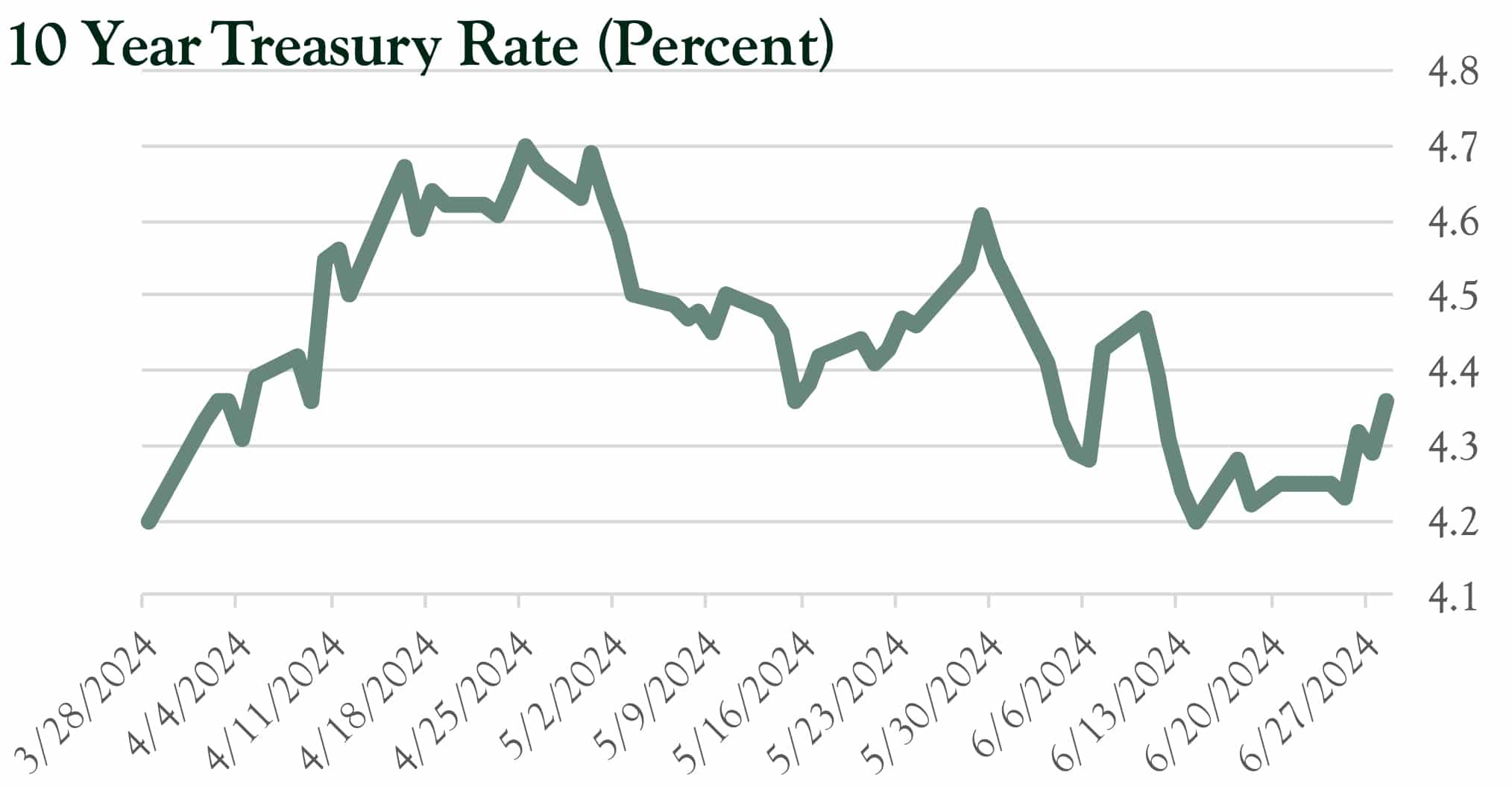
Outlook
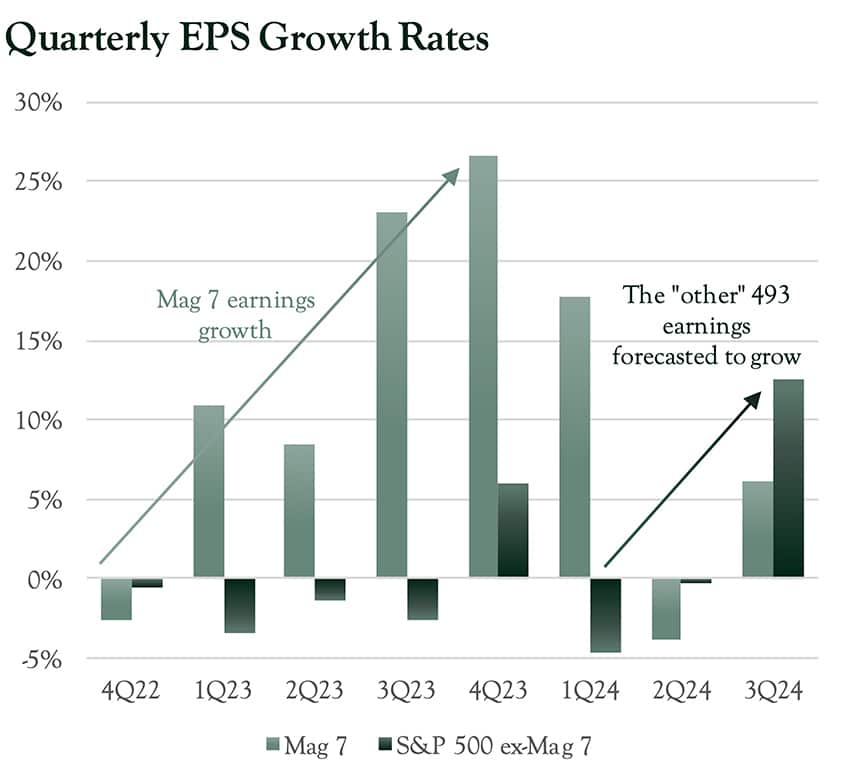
The performance of larger-cap (mostly tech) stocks has been nothing short of exceptional. Rightfully so, as earnings expectations for the Magnificent Seven (e.g., Apple, Alphabet, Amazon, Meta, Microsoft, Nvidia and Tesla) surged in comparison to the “other” S&P 500 constituents. The Mag 7 now makes up more than 32% of the index which has driven the index higher. That trend, however, could change in the third quarter if earnings come through as forecasted for the remaining 493 companies (see EPS Growth chart). Consensus growth rate estimates for these names are expected to exceed that of the Mag 7 for the first time in two years. We expect this to help diversify the performance of stocks within the S&P 500. Our focus, however, is not on eliminating exposure to the Mag 7, but rather broadening exposure to the “other” stocks in the index and shifting our market-cap exposure to equal-weighted indices and more value-oriented funds.
The broadening theme could also help create a renewed interest in small-cap and international equities. As we mentioned in our last letter, the historic valuation gap between US large-cap and small-cap stocks remains disproportionally wide. Continued under-performance has only made the discount to larger-cap stocks that much more appealing for long-term investors. International stocks continue to perplex investors but warrant our attention. International developed markets are short on “tech,” growth stocks, but long on financials and industrials – areas of the market that would be primed for a broadening trade sparked by a reverted yield curve and global expansion. The strong US dollar could also be a catalyst. As other global banks have started to cut their short-term rates, The Fed remains a hold out in joining the easing cycle. If the Fed decides to cut short-term rates this could put some downward pressure on the US dollar and help overseas investments.
One recurring conversation with clients is the upcoming presidential elections. Historically, markets have been agnostic as to which party wins the Presidency. Despite the rhetoric heard through media outlets, the economic foundation of the US is strong. While we all have personal preferences for who the next U.S. President will be (or maybe more apt, who it should not be), the strength of the American consumer should continue to drive earnings for US corporations, and in turn, our markets. At present, both the incumbent and the former President as candidates are known entities. The stock market does not handle uncertainty well, and as such, any change to the political landscape could add volatility prior to the November election.
As always, we will continue to absorb data as it becomes available to position your portfolio appropriately. If you would like to discuss any of the information herein in greater detail, please contact a member of our Team. In the interim, enjoy your summer!
Sincerely,
Your Oarsman Capital Team
